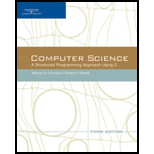
Computer Science: A Structured Programming Approach Using C, Third Edition
3rd Edition
ISBN: 9780534491321
Author: Behrouz A. Forouzan, Richard F. Gilberg
Publisher: Course Technology, Inc.
expand_more
expand_more
format_list_bulleted
Concept explainers
Expert Solution & Answer
Chapter 1, Problem 11PS
Explanation of Solution
Given: The types of files, such as executable, object, application, text, and source file as options.
To find: The file that stores the programmer’s original code.
Solution:
The file that contains the programmer’s original code is the source file...
Expert Solution & Answer
Want to see the full answer?
Check out a sample textbook solution
Students have asked these similar questions
Dijkstra's Algorithm (part 1). Consider the network shown below, and Dijkstra’s link-state algorithm. Here, we are interested in computing the least cost path from node E (note: the start node here is E) to all other nodes using Dijkstra's algorithm. Using the algorithm statement used in the textbook and its visual representation, complete the "Step 0" row in the table below showing the link state algorithm’s execution by matching the table entries (i), (ii), (iii), and (iv) with their values. Write down your final [correct] answer, as you‘ll need it for the next question.
4. |z + 5 - 5i| = 7
14.
dz,
C: |z❘
C: |z❘ = 0.6
ze² - 2iz
H
Chapter 1 Solutions
Computer Science: A Structured Programming Approach Using C, Third Edition
Ch. 1 - Computer software is divided into two broad...Ch. 1 - Prob. 2PSCh. 1 - Prob. 3PSCh. 1 - The programmer design tool used to design the...Ch. 1 - Blackbox testing gets its name from the concept...Ch. 1 - Prob. 6PSCh. 1 - Prob. 7PSCh. 1 - Which of the following is not a computer language?...Ch. 1 - The computer language that most closely resembles...Ch. 1 - Prob. 10PS
Ch. 1 - Prob. 11PSCh. 1 - Prob. 12PSCh. 1 - The is a program design tool that is a visual...Ch. 1 - Prob. 14PSCh. 1 - Describe the two major components of a computer...Ch. 1 - Computer hardware is made up of five parts. List...Ch. 1 - Prob. 17PSCh. 1 - Describe the two major categories of software.Ch. 1 - Prob. 19PSCh. 1 - Prob. 20PSCh. 1 - Prob. 21PSCh. 1 - Prob. 22PSCh. 1 - Prob. 23PSCh. 1 - Prob. 24PSCh. 1 - Prob. 25PSCh. 1 - Prob. 26PSCh. 1 - Prob. 27PSCh. 1 - Describe the three tools that a programmer may use...Ch. 1 - Prob. 29PSCh. 1 - Prob. 30PSCh. 1 - Prob. 31PSCh. 1 - Write pseudocode for calcLivingAreas, Figure 1-12,...Ch. 1 - Prob. 33PSCh. 1 - Prob. 34PS
Knowledge Booster
Learn more about
Need a deep-dive on the concept behind this application? Look no further. Learn more about this topic, computer-science and related others by exploring similar questions and additional content below.Similar questions
arrow_back_ios
SEE MORE QUESTIONS
arrow_forward_ios
Recommended textbooks for you
- Programming Logic & Design ComprehensiveComputer ScienceISBN:9781337669405Author:FARRELLPublisher:Cengage
 Programming with Microsoft Visual Basic 2017Computer ScienceISBN:9781337102124Author:Diane ZakPublisher:Cengage Learning
Programming with Microsoft Visual Basic 2017Computer ScienceISBN:9781337102124Author:Diane ZakPublisher:Cengage Learning EBK JAVA PROGRAMMINGComputer ScienceISBN:9781337671385Author:FARRELLPublisher:CENGAGE LEARNING - CONSIGNMENT
EBK JAVA PROGRAMMINGComputer ScienceISBN:9781337671385Author:FARRELLPublisher:CENGAGE LEARNING - CONSIGNMENT  Microsoft Visual C#Computer ScienceISBN:9781337102100Author:Joyce, Farrell.Publisher:Cengage Learning,
Microsoft Visual C#Computer ScienceISBN:9781337102100Author:Joyce, Farrell.Publisher:Cengage Learning, EBK JAVA PROGRAMMINGComputer ScienceISBN:9781305480537Author:FARRELLPublisher:CENGAGE LEARNING - CONSIGNMENT
EBK JAVA PROGRAMMINGComputer ScienceISBN:9781305480537Author:FARRELLPublisher:CENGAGE LEARNING - CONSIGNMENT C++ for Engineers and ScientistsComputer ScienceISBN:9781133187844Author:Bronson, Gary J.Publisher:Course Technology Ptr
C++ for Engineers and ScientistsComputer ScienceISBN:9781133187844Author:Bronson, Gary J.Publisher:Course Technology Ptr

Programming Logic & Design Comprehensive
Computer Science
ISBN:9781337669405
Author:FARRELL
Publisher:Cengage

Programming with Microsoft Visual Basic 2017
Computer Science
ISBN:9781337102124
Author:Diane Zak
Publisher:Cengage Learning

EBK JAVA PROGRAMMING
Computer Science
ISBN:9781337671385
Author:FARRELL
Publisher:CENGAGE LEARNING - CONSIGNMENT

Microsoft Visual C#
Computer Science
ISBN:9781337102100
Author:Joyce, Farrell.
Publisher:Cengage Learning,

EBK JAVA PROGRAMMING
Computer Science
ISBN:9781305480537
Author:FARRELL
Publisher:CENGAGE LEARNING - CONSIGNMENT

C++ for Engineers and Scientists
Computer Science
ISBN:9781133187844
Author:Bronson, Gary J.
Publisher:Course Technology Ptr